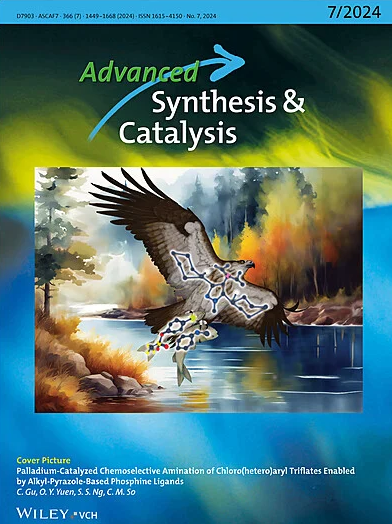用异氰酸酯改善吡啶到 1,2-二氮杂环庚烷的光化学放大作用
IF 4.4
2区 化学
Q2 CHEMISTRY, APPLIED
引用次数: 0
摘要
在这项工作中,我们扩展了一锅法合成 1,2-二氮杂卓的方法,使用的起始材料从市场上可以买到,而且价格低廉。利用异氰酸酯衍生物作为活化剂,在保留 30 多种底物中的关键官能团的同时,实现了光化学骨架的放大。我们还证明,异氰酸酯可以利用丰富的方法从台架稳定资源中就地生成。与之前的策略相比,使用这些前体可以防止系统中出现有害的盐酸痕迹,从而可以通过多达 5 个连续步骤高产率合成 1,2-二氮杂卓。本文章由计算机程序翻译,如有差异,请以英文原文为准。
Improving the Photochemical Skeletal Enlargement of Pyridines to 1,2-Diazepines with Isocyanates
In this work, we extend the one-pot protocol to synthesize 1,2-diazepines from commercially available and cheap starting materials. Capitalizing on isocyanate derivatives as activating agents, the photochemical skeletal enlargement occurs, while preserving key functional groups embedded in more than 30 substrates. We also demonstrated that isocyanates can be generated in situ exploiting the wealth of methods starting from bench stable resources. Compare to previous strategies, the use of these precursors prevents the presence of deleterious HCl traces in the system, thus enabling the synthesis of 1,2-diazepines in high yields over up to 5 sequential steps.
求助全文
通过发布文献求助,成功后即可免费获取论文全文。
去求助
来源期刊

Advanced Synthesis & Catalysis
化学-应用化学
CiteScore
9.40
自引率
7.40%
发文量
447
审稿时长
1.8 months
期刊介绍:
Advanced Synthesis & Catalysis (ASC) is the leading primary journal in organic, organometallic, and applied chemistry.
The high impact of ASC can be attributed to the unique focus of the journal, which publishes exciting new results from academic and industrial labs on efficient, practical, and environmentally friendly organic synthesis. While homogeneous, heterogeneous, organic, and enzyme catalysis are key technologies to achieve green synthesis, significant contributions to the same goal by synthesis design, reaction techniques, flow chemistry, and continuous processing, multiphase catalysis, green solvents, catalyst immobilization, and recycling, separation science, and process development are also featured in ASC. The Aims and Scope can be found in the Notice to Authors or on the first page of the table of contents in every issue.
 求助内容:
求助内容: 应助结果提醒方式:
应助结果提醒方式:


